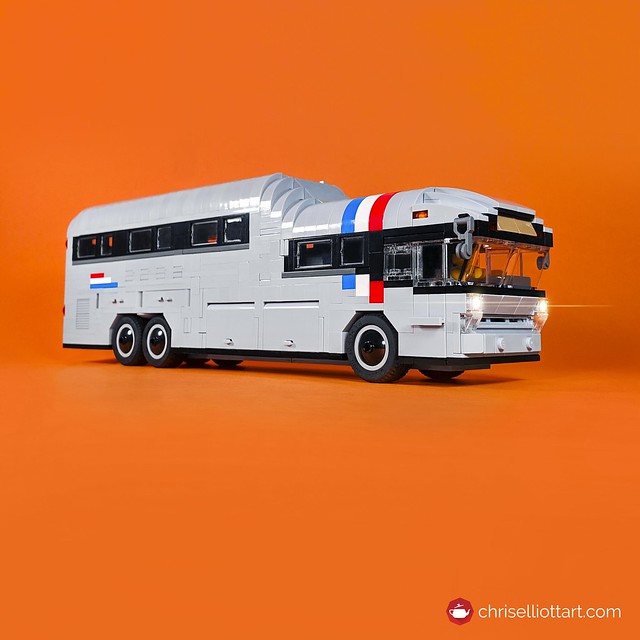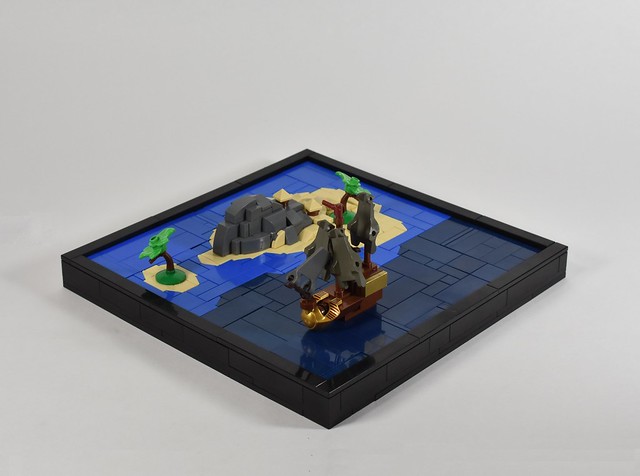Theodore Tugboat was an icon of Canadian children’s television in the late 1990’s. As a Canadian that grew up in the 90s, Julie vanderMeulen LEGO recreation of Theodore hits the nostalgia just right for me. The face and hat are sculpted perfectly to evoke Theodore’s friendly, happy-go-lucky attitude. Looking past the character, this is also an excellent model of a tugboat. All the details, such as railings and spotlights, are present to help make it authentic. Not satisfied to simple mount the tires on the side, Julie has added LEGO string elements to make them look as if they’re actually tied on.
Posts by David Guedes
This Mustang is in the shop for repairs
You may have noticed an abundance of Ford Mustangs featured on The Brothers Brick lately. The recent trend was ignited by a LEGO IDEAS contest, celebrating the Mustang in beautiful scenery. After wowing us by finding a Mustang in a barn, Andrea Lattanzio’s latest creation finds this Mustang in the shop. While the car itself is flawless, focus of the contest is on the scenery. And this garage is spot on.
The structure is rife with subtle yet brilliant techniques, from the checkered pattern on the wall – alluding to the shop owner’s dreams on race day – to the broken window adding that extra dose of realism. My favourite technique is the droid arms and skeleton legs suspending the overhead lights. Not to be overlooked is the apparent master class in brick built garage and warehouse tools. The pallet jack, air compressor, drill press, gas pump and table vice are all amazing details that help make this garage beautiful.
Party on in this re-themed Slave I
When a piece that’s exclusive to one set gets released in a new colour, it can be appealing to base a tribute to the original set around the new piece. That’s exactly what BobDeQuatre has done with the transparent purple windscreen from the LEGO Movie 2 70828 Pop-Up Party Bus set, which had previously only existed in transparent clear in the Ultimate Collector’s Series 75060 Slave I.
While many parts of the original model could be substituted for parts in the right colour scheme, some had to be replaced if the correct parts didn’t exist. I especially like the way the curves over the wing mounts were sculpted. If you look closely, you’ll notice that the weapons have been removed, as this ship is built to have fun, not chase the Millennium Falcon. And what better way to emphasize its readiness to party, than with a fun pair of cat ears. Meow!
Bionicle dragon rises from the water
It’s amazing what a talented LEGO builder can achieve when they step outside their comfort zone. Andreas Lenander was inspired to build something “Bionicle-ish” and I think he nailed it. The contrast in building styles between the complex dragon and the studs-up base is the perfect way to make the dragon stand out.
The dragon’s neck is particularly well done, being constructed mainly out of robot arms to resemble scales. Robot arms are actually used throughout, also being used for teeth and the tips of the black horns. The Piraka leg pieces are the ideal choice for the ridge of the dragon’s face: they give it that undeniably rigid-skinned lacertilian look.
Classic space goes to the chapel
Many depictions of space men visiting earth depict them making contact during modern times, but who’s to say they might not have visited in the past? That’s exactly what looks to be happening in Ralf Langer’s latest creation. But the visitors from space are not the only thing that’s out of this world in this little chapel – the parts usage is seriously stellar!
Ralf was inspired to build the chapel by a challenge to use the new Big Ugly Ship Hull for something other than a spaceship, and he integrates it so well here that I didn’t even notice it at first glance. Advanced building techniques abound in the construction of the chapel, from the complicated yet smooth circular wall to the chain link rooftop. My personal favourite is the front door – I can’t figure out how he achieved the herringbone inlay, but the end result is stunning.
A rustic barn with a classic Ford Mustang
Some LEGO builders say that architecture and scenery merely exist to serve as backdrops for cars or trains. Looking at this display built by Andrea Lattanzio, I beg to differ. While the classic first-series Mustang Hardtop is beautiful on its own, the barn behind it is equally delightful. Andrea achieved the barn’s dilapidated look through effective use of brown and dark grey tiles, which are not pressed down all the way. Personally, I find it difficult to ignore the satisfying feeling of pressing two LEGO pieces together but, when they’re tilted just a little and with varying degrees, the rustic charm is undeniable.
Other highlights include the rusty broken gas pump and an American flag, which is cleverly formed out of plates with clips in such a way that makes it look as if it’s waving in a light breeze. The car itself cannot be overlooked; the lines are sleek and the construction is smooth. Curved slopes on the hood are ideal parts in creating the perfect angle, and the use of clear slopes for the windshield is simple but feels representative of a real Mustang.
A bookmobile to behold
Some vehicles are more than meets the eye. While this 1959 Salem Ameriliner Library Bus by Chris Elliott doesn’t change into a walking, talking robot, it has been transformed on the inside, from a passenger carrier to mobile library with a fully detailed interior. Even without the interior, the bus is a beautiful creation. The combination of slopes used on the roof place it indisputably in the 1950s, and the other details are seamless: doors on their side as luggage compartment doors and zip line handles as side view mirrors.
If you’re not impressed by the exterior, open it up and be prepared to be blown away. The interior of this bookmobile is spot on to the last detail. It starts with enough books to actually be called a library, stowed everywhere they could possibly go: on the walls, in the luggage compartment, and even in the floor. There’s even a comfy couch in the back to curl up with whatever good book you’ve found on the shelf!
Continue reading
Sail away on crocodile head power
No LEGO creation impresses me more than a well done microscale build. When building bigger, you can essentially sculpt any shape imaginable with basic bricks and plates. With microscale however, the parts you choose can make or break your design. Take david zambito’s Calm Seas for example, and focus on the trees and the ship. AT first glance, the trees might look pretty straightforward since he uses a leaf to represent a tree canopy. For their trunks though, he’s used a long horn instead of a straight bar, and this choice makes the tiny palm trees lean in a way that feels natural.
Next up is the brilliant little ship. Before I gush about the bow and sails, I’d like to recognize the apt use of a droid arm as the bowsprit. While it wouldn’t have been my first choice, now that I’ve seen it, I can’t think of a better piece to use in its place. Now on to the true stars of this build…. The obvious standouts are the crocodile heads as sails, which stand out as trapezoids, whereas most LEGO elements are rectangular. What’s more, the ridges over the eyes make them appear to be blowing in the wind. My favourite aspect of the entire build is the mummy’s headdress as the bow of the ship. Not only does the part fit in with the scale, but its functional areas are both used: the ship connects to the inside where a minifgure head would normally go, and the stud on the front of it is the connection point for the bowsprit. Take a closer look yourself and see what other amazing parts usage you can find.
In this giant castle, every little detail is beautiful
Whether made out of real-life bricks or LEGO bricks, castle walls can be as simple as bricks stacked one on top of the other. However, some real castles have detailed walls, as does this LEGO castle by amenk sachio. The combination of sloped and arched grey bricks make the giant stone walls appear as if they were designed to be part of the finest renaissance château.
Particularly cunning is the use of socket joints to create arches: the wider end makes them naturally curve when stacked – an effect utilized here to great success. On top of the fine masonry, this castle is adroitly adorned with golden embellishments, with plant, animal, and weapon pieces used to create architectural details. My favourite detail of all is the repeated use of Witch-King crowns throughout, tying the entire fortress together.
An Imperial probe droid. It’s a good bet the Empire has seen this perfect reproduction
Sometimes you look at a creation and don’t even realize you’re looking at something built out of LEGO bricks. That’s exactly what Lino Martins has achieved with his Imperial Probe Droid. At first glance, you might mistake the Arakyd Industries Viper probe droid for an action figure, but upon closer inspection you realize that it is, in fact, made up of LEGO elements. 
Of course, it helps that he’s used certain pieces that are perfect substitutes for what is seen in the Empire Strikes Back, for example the Technic pins look almost identical to the ends of the antenna. And that’s just starting at the top – scanning the rest of the model shows more and more components that look enough like the reel thing to make you think it’s searching for your hidden Rebel base.








